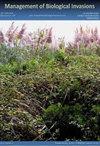Preparing to eradicate a novel invader of unknown biology: a case study from Australia
IF 1.2
4区 环境科学与生态学
Q3 BIODIVERSITY CONSERVATION
引用次数: 0
Abstract
Although there have been many attempts at eradicating exotic ant incursions, most efforts have been unsuccessful, and a lack of specific biological knowledge is believed to have been a major contributing factor. In early May 2013, an exotic ant species, Lepisiota frauenfeldi , was found for the first time in Australia. Identifying the species proved difficult, and little biological information about the species was available. In making the decision to eradicate and develop the treatment protocols, four assumptions were made about the ant’s biology. Here we detail rapid and basic research that was used to assess the assumptions underpinning the decision to eradicate, contribute to determine some eradication protocols for this understudied species, as well as how our understanding increased following the discovery of two other incursions of this species in Australia. The research found that all initial assumptions of the ant’s biology used in the original eradication plan were wrong. Distribution modelling found the ant could potentially inhabit a larger area than first thought, and updating the model with the subsequent incursions greatly increased the area of suitable climate in Australia. The ant’s foraging and reproductive regimes were not as expected, so too its nutrition pathways to queens, which had implications for the treatments. Our work serves as a clear warning for invasive species practitioners that management decisions that are based on assumptions, “gut feelings” or knowledge based on information from elsewhere in the world, or from other species, can be expected to be flawed. Rapid, small-scale and strategic research conducted on-site can enhance management outcomes.准备消灭一种未知生物的新入侵者:来自澳大利亚的案例研究
尽管已经有许多根除外来蚂蚁入侵的尝试,但大多数努力都是不成功的,缺乏特定的生物学知识被认为是一个主要的因素。2013年5月初,在澳大利亚首次发现了一种外来蚂蚁——Lepisiota frauenfeldi。鉴定该物种被证明是困难的,而且几乎没有关于该物种的生物学信息。在决定根除和发展治疗方案时,对蚂蚁的生物学做出了四个假设。在这里,我们详细介绍了用于评估支持根除决定的假设的快速和基础研究,有助于确定对这种未充分研究的物种的一些根除方案,以及在澳大利亚发现另外两种该物种入侵后我们的理解如何增加。研究发现,最初根除计划中对蚂蚁生物学的所有假设都是错误的。分布模型发现,蚂蚁可能栖息在比最初想象的更大的区域,并且随着随后的入侵而更新模型,大大增加了澳大利亚适宜气候的区域。蚂蚁的觅食和繁殖机制并不像预期的那样,它给蚁后的营养途径也是如此,这对治疗有影响。我们的工作对入侵物种从业者发出了明确的警告,即基于假设、“直觉”或基于来自世界其他地方或其他物种的信息的知识的管理决策可能会有缺陷。现场进行的快速、小规模和战略性研究可以提高管理成果。
本文章由计算机程序翻译,如有差异,请以英文原文为准。
求助全文
约1分钟内获得全文
求助全文
来源期刊

Management of Biological Invasions
Agricultural and Biological Sciences-Ecology, Evolution, Behavior and Systematics
CiteScore
3.40
自引率
6.70%
发文量
21
审稿时长
16 weeks
期刊介绍:
Management of Biological Invasions, established in 2010 by Dr. Elias Dana, is an open access, peer-reviewed international journal focusing on applied research in biological invasions in aquatic and terrestrial ecosystems from around the world. This journal is devoted to bridging the gap between scientific research and the use of science in decision-making, regulation and management in the area of invasive species introduction and biodiversity conservation.
Managing biological invasions is a crisis science, with Management of Biological Invasions aiming to provide insights to the issues, to document new forms of detection, measurements and analysis, and to document tangible solutions to this problem.
In addition to original research on applied issues, Management of Biological Invasions publishes technical reports on new management technologies of invasive species and also the proceedings of relevant international meetings. As a platform to encourage informed discussion on matters of national and international importance, we publish viewpoint papers that highlight emerging issues, showcase initiatives, and present opinions of leading researchers.
 求助内容:
求助内容: 应助结果提醒方式:
应助结果提醒方式:


